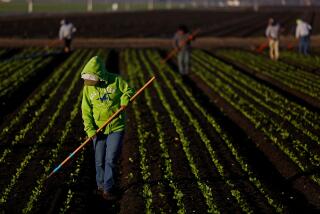Program Lets Farmers Direct U.S. Aid to Each Other
- Share via
DALHART, Tex — R.B. Reynolds decides how to spend millions of federal agriculture dollars each year. He implements federal policy and sometimes hires or fires a government worker.
Reynolds, however, is neither federal bureaucrat nor politician, but a wheat and corn farmer here in wind-swept Hartley County.
He was elected by his Texas Panhandle neighbors to be chairman of the three-member committee that runs Hartley County’s office of the Agricultural Stabilization and Conservation Service.
Every U.S. county with some agriculture has a three-farmer committee elected by fellow farmers to direct the local office of the ASCS, which runs all the multibillion-dollar federal agriculture payment programs.
It’s a job considered unique among government aid programs, with the very recipients of federal dollars deciding who gets how many.
Potential problems and conflicts are obvious: Would welfare mothers determine their friends’ monthly checks or students decide roommates’ eligibility for loans? But agriculture officials believe the elected committee members are in the best position to assess fairly the losses suffered by their neighbors--and to keep them honest.
“We have to follow the rules that come down, but we try to represent the farmer and his needs and what would be best for him,” Reynolds said. “If you don’t represent the farmer, who’s going to?”
The question of who to protect, the farmer or the government, is at times a difficult one for conscientious committee members. One day after Reynolds sided with farmers in an interview, he told a reporter he preferred to say committee members have to represent both sides and “mediate to try to work something out.”
Most committee members interviewed for an Associated Press study of the 1988 drought-relief effort said they voted for the good of their neighbors whenever possible.
“I would say you’re representing the farmer--maybe that’s not the way it’s supposed to be,” said Mike Bouris, chairman of the Riverside, Calif., county committee.
“You don’t want your neighbor to be mad at you because he didn’t qualify,” said John Rigolizzo Jr., the Camden County, N.J., committee chairman. “Yes, you could say he’s sticking up for his buddy and his neighbor, but when we’re in this office, we’re government employees.”
Committee members, who are paid small stipends for their meetings, take an oath of office pledging to uphold the laws of Congress. Agriculture Department officials say they expect the committees to protect taxpayers as well as be fair to farmers.
“They represent both, but they have rules and regulations they have to obey,” Dan Shaw, the ASCS deputy administrator in charge of state and county operations, said from Washington, D.C.
“They can’t just say this is a deprived area so let’s take all the money in the Treasury and throw it out here,” Shaw said. “We feel peers are the people who can make the really good, accurate decisions that need to be made.”
Committees have great latitude in administering agriculture programs, from establishing normal harvests to deciding whether a crop was cultivated properly. They must sometimes analyze farmers’ financial standings and sort through corporations, partnerships and trusts. They also have to interpret an array of laws and regulations.
“Some guidelines leave a lot for us to interpret. The smart people can read that and find ways to get around it,” said Don Gronewald, a hay farmer who is a member of the Kaufman County, Tex., committee.
“All of the programs are good programs, and when they put them out they had good intentions. But you’re going to find somebody abusing and using the program to their benefit, and that makes it harder for the honest Joe,” Gronewald said.
Agriculture experts say farming in America is so vast that the local committee system is the only fair way to administer the aid programs.
“There are these glitches. Two counties end up rendering two different decisions,” said Bob Bergland, agriculture secretary under former President Jimmy Carter. “But you have to have room for local judgment. I’d say it works better than almost any other scheme you can think of.”
In the case of the drought program, many committees had to set crop yields and estimate how much would have been harvested in a normal year, as well as decide if a farmer kept his crop properly fertilized, weeded and, if possible, watered.
And the committees of three had to decide whether each applicant farmer was eligible.
In some cases, a county committee was more gracious with its constituents than either insurance companies evaluating the same losses or committees in neighboring counties interpreting the same regulations, the AP found.
A crop insurance company balked at paying one Oklahoma farmer an irrigated yield of 69 bushels per acre on his damaged milo because he had watered just once. Insurance paid only the dry-land yield of 28 bushels. But the county committee granted drought relief based on the irrigated 69-bushel yield. The farmer received $4,467.
“The committee made a determination that it was watered,” said David F. Barnes Jr., director of the Texas County, Okla., ASCS office.
The Chaves County, N. M., committee decided to pay a farmer $18,285 for cotton damage caused by “cold, rainy weather” and “high winds,” although the bill contained provision for neither freeze-like damage nor wind damage.
The drought-relief program was particularly troublesome for some committees because it was set up with such haste, officials said. Some farmers harvested their crops before applying for aid, making losses difficult to verify.
In Gaines County, Tex., ASCS director John Wayne Hall said he struggled with 1988 claims for lost winter wheat--a crop planted in 1987 and cut months before Congress even considered the drought legislation.
“How can I know what kind of product that boy had out there? It was long gone,” Hall said. “In ‘88, we made a lot of judgments.”
A recent General Accounting Office report noted that the 1988 relief program was hard to administer because it required county officials to determine, on short notice, payments on close to 500 crops, from almonds to zucchini.
More to Read
Sign up for Essential California
The most important California stories and recommendations in your inbox every morning.
You may occasionally receive promotional content from the Los Angeles Times.










